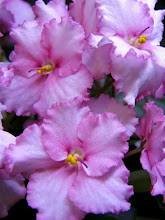I spent some time Saturday and Sunday doing more volunteer time with the DNR. ON Saturday we gathered burn piles of invasive shrubs that had already been cut by the DNR. They do this to maintain the prairie and the native plant life in that environment. It poured on us the whole time, but we kept at it for a couple of hours until the lightning began to strike. There were about 30 volunteers and we accomplished quite a bit in a short time, despite the weather.
On Sunday the rain was gone - just 90 degree weather, sunny skies, and heavy steamy air. We hiked through the woods cutting down invasive Common Buckthorn, Glossy Buckthorn, and Autumn Olive. Each shrub we could find was cut and herbacide was applied to the stump to prevent it from growing again. We also found and removed a few small patches of an invasive species of Parsley.
 (Photo by Bill Brandon)
(Photo by Bill Brandon)The day was also a great opportunity to learn MANY of the native plants!

Maindenhair Fern
(
Adiantum pedatum)

I think this is
Tickseed-Sunflower
(
Bidens coronatus),
but it is possibly
Western Sunflower
(
Helianthus occidentalis)

White Baneberry
(
Actaea pachypoda),
also called Doll's Eyes
TOXIC

Red Baneberry
(
Actaea rubra)
Also TOXIC

I'm going to be tagging along on some individual projects for the DNR as well. I'm going to be learning Photo Monitoring, Insect Monitoring, and hopefully Seed Collecting. I get together with one of the current Photo Monitoring volunteers at the end of the month to see how it's done. I'm very much looking forward to it!




.jpg)

.jpg)



























